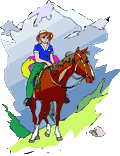Danger Signs to Watch for with Your Horse
Danger Signs to Watch for with Your Horse
PANTING: If the horse is unable to catch its breath when you stop, slow down. Walk the horse until it is breathing easily. Then continue, but at a much slower pace
LAMENESS: To tell if the horse is lame, look at its head. It will bob each time a certain foot hits the ground. It is easier to spot this at a trot. Check the legs for swelling.
DEHYDRATION: When the horse's system doesn't have enough water, it is dehydrated. If the horse's flanks are drawn up, it is probably getting dehydrated. To test for dehydration, pull up the skin on the horse's neck. If the skin does not snap back immediately, the horse is dehydrated. The slower the skin is to return to place, the more severe the dehydration.
GUM COLOR: If the horse is getting out of breath, tired, or dehydrated, check the gum color. The normal color of gums is a light pin. A whitish pink, reddish-deep pink, or blue gum color is an indication of trouble.
TYING-UP: In tying-up, the muscles on the rump become rock hard. The horse may quiver, you can't push into the muscles of the rump as you normally can, in a horse that is tying-up. Stop, do not move your horse.
THUMPS: The horse seems to have constant. rhythmic ticking in the flanks; i.e. the skin between the back legs and the belly twitch, when the horse has the thumps. In a severe case of the thumps, the whole abdomen will have this ticking motion and the body will quiver.
COLIC: The horse will be in pain. Looking back at its flank, and/or trying to roll are signs of colic.
The above things are DANGER SIGNS that your horse is being stressed. Keep an eye out for these signs throughout your ride.
By Patricia Harrop, DVM, Technical Advisor

- Log in to post comments
